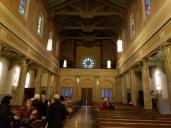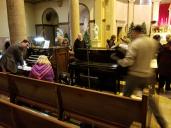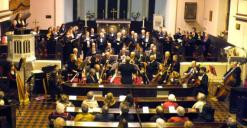Placement of choir
-
We are a small parish and the organ sits in front of the first pew. Is it permissible to have choir members stand on the first step of the sanctuary and also the main flow when singing during Mass? They would then return to the pews after each hymn. Please be as specific as possible in citing any document covering this issue. (I could find anything specific in GIRM 2000) Thanks!
-
Argentarius,
Unfortunately, the situation isn't as simple as you propose. Historically speaking, there are some church buildings with a special feature called a "quire", where the trained singers and/or monastics sit for antiphonal singing. In modern times, when there is no architectural feature noting the sanctuary, and none marking the Communion rail, choirs are often placed behind the altar, facing the people, or prominently obscuring the altar. These are bad ideas.
Can a schola be placed on the first step of the sanctuary? I've seen a schola at the transcept in a parish which is unarguably traditional in its praxis. -
Argentarius - for documentation - Some advice from USCCB here in Para 88ff: https://nyliturgy.org/wp-content/uploads/BOLS.pdf and that references other places to look.
And warning you are probably going to get lot of comments here that "hymns have no place at Mass" and other contentious points. So - what is the role of your choir? if it is to support the congregation, this might be better done from behind, or to one side. If a hymn is to accompany liturgical action, you don't want them blocking the view of the action! -
Yeah, I know, but debating the appropriateness of hymns at Mass isn't going to solve my problem. The parish is four hymn standard. The organ sits in the front of the first pew, so putting the choir in the loft is not workable. They currently are in the front pews with one mic. The church was built in the 60's and obviously no thought was given to any of this. To move the organ is an expense the parish cannot handle. I do not like the idea of choir members standing in the sanctuary. It seems so irreverent and likely lead to confusion, them going back and forth, - and which book do we need now ? and I forgot my glasses etc. - I'm being pushed into this by a vocal parishioner and a pastor who should but doesn't know better.
-
Built of Living Stones:Art, Architecture, and Worship
USCCB
90. ... The placement and prayerful decorum of the choir members can help the rest of the community to focus on the liturgical action taking place at the ambo, the altar, and the chair. The ministers of music are most appropriately located in a place where they can be part of the assembly and have the ability to be heard. Occasions or physical situations may necessitate that the choir be placed in or near the sanctuary. In such circumstances, the placement of the choir should never crowd or overshadow the other ministers in the sanctuary nor should it distract from the liturgical action. -
This presents the unique challenge of determining precisely where the musicians are best accommodated ... as both worshippers and ministers. A location which positions the musicians within the assembly at a non-intrusive but somewhat forward space, and which, at the same time, allows their view of and attention to the altar/sanctuary is to be desired. http://www.odwphiladelphia.org/wp-content/uploads/2014/02/LocationofChoirandMusicalInstruments.pdfDe musica sacra et sacra liturgia III-4 (1958): 67. The organ should be located in a suitable place near the main altar, unless ancient custom or special reason approved by the local Ordinary demand otherwise; but the location should be such that the singers or musicians occupying a raised platform are not conspicuous to the congregation in the main body of the church
-
Coming back to this.
All documents, modern and ancient, agree that the choir is part of the congregation, as far as possible to be heard but not seen.
Nobody should be looking at the congregation except when directly addressing them - cantor, homilist, lector, celebrant in his brief dialogues. So if standing on the steps means facing the congregation then absolutely not.Thanked by 1hilluminar -
Some choirs could be placed in the parking lot with no harm done to either liturgy or parishioners.
-
Charles,
May I make your comment without the purple? -
It's too bad. The choir shouldn't be a distraction, so seating them and then having them stand would be the best alternative... but as to having them move, well, that is a real distraction, and gets the ego bird in motion not to mention the large distraction away from the liturgy itself.
-
Some choirs could be placed in the parking lot with no harm done to either liturgy or parishioners.
Ahhh....except without them there may not be any singing at all (and yes, this is not in purple). -
Perhaps a picture and a clearer description of the room and it's acoustics would help
-
Is it possible to pull out the first pew or two, and place chairs in a semi-circle instead? Facing the front, or slightly to the center?
So many parish choirs seem to line up choir members in a straight line, possibly with their own individual microphones. I don't understand it. -
Two scenarios that require working with odd architecture:
1) local parish, really unchurchlike modern building. "sanctuary" is a raised stage-like area that goes fully from left to right, wall to wall. Altar takes up a small part in the middle, there is one podium from which all readings and the psalm singing are done. The areas to the sides of the altar are not needed for active liturgical use. One side has some chairs and large statuary. The other side is used by musicians and choirs. They have the electronic organ on the main floor, by the wall, and then the singers arrange two rows of chairs facing the congregation. They stand to sing and sit when the congregation sits. They move to the first two rows of pews nearby for the Consecration, then return to their chairs. They are visually some 40 degrees to the right of the altar (for a congregant sitting in the middle of the church), so they aren't distracting. They wear modest white shirts/blouses and black pants/skirts. Additional instruments like guitars, saxophone, drum, etc are on the floor level along the wall near the organ. During the week, when there are just one or two singers, they stand next to the organ on the floor level, facing the congregation, but off to the side enough that one doesn't notice them much.
scenario two: centuries old church which used to have a sanctuary, an altar rail, then an area for the seating of the confraternity, then another altar rail, then the area for the public congregation. After the Post-Conciliar altar adjustments, the first altar rail was removed (the holes are visible in the floor) and a wooden platform was built to extend the sanctuary into the former confraternity area. The other altar rail was left in place. So what happens is the former confraternity area, which is quite large (could seat 50) is now "the sanctuary". However, we are overflowing every Sunday, with people sometimes fainting in the tropical heat, so the priest asked us to just use some extra rows of chairs along the walls in that area, leaving the front row on each side for the servers and such. In order to facilitate Communion the choir also runs down from the choir loft right after the Agnus Dei, mumbling the Confiteor along the way, kneels behind the altar servers who are going to receive Communion first, then moving over to the side of that area to sing the Communion antiphon and psalm while the rest of the congregation receives and the priest goes back to the altar. When he shuts the tabernacle door we wrap up the psalm and head back upstairs, which gives us a moment to catch our breaths and then sing a post-Communion hymn.
It's weird working with the great variety of architecture, liturgical styles, instruments, and other variables...Thanked by 1Elmar -
argentarius, I thought I would offer a similar situation to yours. This Sunday, I visited St. Mary's Parish in Akron, Oh; my alma mater, for a "come back mass". It was a mass especially for former parishioners and alumni. I sat two pews behind the organ situated in the main body of the church and back one pew from the altar communion rail. Yes, St. Mary's still has a communion rail. I sang in the choir here for thirty-three years and needless to say, it was "good" to hear the organ "swell" again and be inside St. Mary's.
More to the point, they have a small group of 4 singers and as you will see in the accompanying photos they removed two pews to make room for singers and a piano. There is a choir loft and there is an organ in the loft but it is not used. I think because one of the singers is not able to climb the stairs and because it is a very small group. I don't advocate that this is a solution but as they say "it is what it is".
 stmarys-2020-3.jpg612 x 459 - 226K
stmarys-2020-3.jpg612 x 459 - 226K
 stmarys-2020-1.jpg594 x 792 - 335K
stmarys-2020-1.jpg594 x 792 - 335K
 stmarys-2020-2.jpg612 x 459 - 225K
stmarys-2020-2.jpg612 x 459 - 225K
 stmarys-2020-4.jpg594 x 792 - 419KThanked by 1a_f_hawkins
stmarys-2020-4.jpg594 x 792 - 419KThanked by 1a_f_hawkins -
Just about the best arrangement, is seen in my local Anglican church. This view, which is not liturgy, has the ladies of the choral society in the stalls designed for the choir.

 87018244_87018238_WIND-24-.JPG570 x 295 - 95K
87018244_87018238_WIND-24-.JPG570 x 295 - 95K -
Don9of11, in that setup do the singers sing towards the altar or towards the congregation? Which way do they face when singing?
General question: how were choir lofts used in the old days when they were built? Did elderly people and those with creaky knees go up and down the stairs despite the difficulty? One loft I know has a spiral staircase, which is dreadful. Another is a very long, high narrow set of stone steps. They are rarely easy to get to. Does anyone know?Thanked by 1Don9of11 -
Elderly people haven't always been as prone to need elevators, cushions, kneelers, hearing aids and such....
-
General question: how were choir lofts used in the old days when they were built? Did elderly people and those with creaky knees go up and down the stairs despite the difficulty? One loft I know has a spiral staircase, which is dreadful. Another is a very long, high narrow set of stone steps. They are rarely easy to get to. Does anyone know?
In the days when the life expectancy was drastically lower, and most everyone was either a farmer or spent their days doing something other than than sitting, I doubt it was an issue. My choir loft was built when people did well to live until their 40s; I doubt many of them were dealing with canes or walkers.Thanked by 1Don9of11 -
CatherineS , the singers face the altar, they have microphones stands which they use. When I sang in the choir (1977 - 2010); there were several who who walked up the choir steps despite the difficulties it placed on them. I remember John Petros who was 90 would come up. I think when walking up steps becomes painful it's up to that choir member to see the wisdom of not continuing.
-
Of course in days of old people at a sung Mass would almost never receive communion.
Welcome to the MusicaSacra Forum!
To participate in the discussions on Catholic church music, sign in or register as a forum member, The forum is a project of the Church Music Association of America.
Categories
- All Discussions21,096
- General Music Discussion8,211
- Job Openings197
- Management of Music Programs850
- Choral Matters532
- Church Documents and Rubrics524
- CMAA Notes301
- Events716
- For Newcomers: Read First26
- Sacred Polyphony546
- Hymnody872
- Gregorian Chant: General2,697
- ↳ Graduale Romanum and Liber Usualis368
- ↳ Graduale Simplex60
- ↳ Semiology63
- Vernacular Plainsong696
- Anglican Use and Anglican Chant68
- Organ, Other Instruments and Repertoire435
- New Composition/Works in Progress1,290
- Recordings230
- Music for Hispanic Ministry159
- Music Education: Children211
- Music Education: General222
- News Items245
- Positions Wanted2
- General Discussion: Catholicism739
- Amusements177
- General Discussion1,033
- Opinions117


